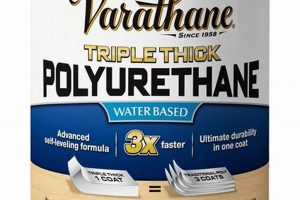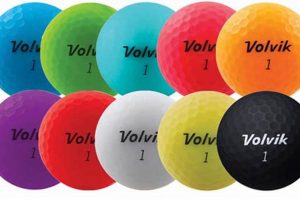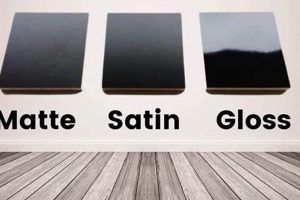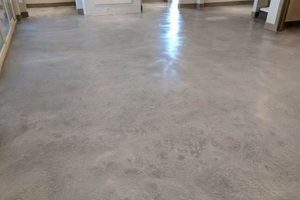A non-glossy coating for fingernails and toenails, this specialized treatment results in a flat, velvety appearance. Applied as a topcoat over colored polish, or available as a stand-alone product, it eliminates shine and provides a contemporary, sophisticated alternative to traditional high-shine manicures. For example, a dark crimson shade, when paired with this treatment, presents a dramatic and understated effect.
The enduring popularity stems from its versatility and ability to enhance various nail art designs. It offers a modern aesthetic, proving especially useful for showcasing intricate patterns or textures without the distraction of excessive gloss. Historically, while polished nails have signified elegance, this treatment offers a stark contrast, signaling a move towards more minimalist and refined styles. Its durability is also a key factor, often concealing minor imperfections better than glossy counterparts.
The following sections will explore application techniques, longevity considerations, and trending color combinations that complement the described aesthetic. Furthermore, the advantages and disadvantages compared to other nail finishing options will be thoroughly examined, alongside maintenance and removal procedures.
Guidance for Achieving an Optimal Non-Glossy Nail Surface
The following guidelines offer practical advice for successfully applying and maintaining a non-glossy nail surface, ensuring a professional and long-lasting result.
Tip 1: Prioritize a smooth base. Imperfections are more noticeable without a glossy sheen; therefore, meticulously buff the nail surface before application.
Tip 2: Apply thin coats of colored polish. Thick applications increase the likelihood of bubbling and uneven drying, which are amplified by a non-glossy topcoat.
Tip 3: Use a dedicated non-glossy topcoat. While some base coats may claim to have a non-glossy effect, a specifically formulated topcoat yields the most consistent and desirable finish.
Tip 4: Allow sufficient drying time between coats. Premature application of the topcoat can result in streaking and an uneven texture.
Tip 5: Avoid exposure to excessive oils or lotions immediately after application. These substances can alter the intended finish and reduce longevity.
Tip 6: Cleanse nails with alcohol before application. This removes residual oils and ensures optimal adhesion of the polish layers.
Tip 7: Consider the color palette. Certain hues, such as deep jewel tones and neutral shades, are particularly enhanced by a non-glossy treatment.
By adhering to these recommendations, individuals can effectively achieve and maintain a sophisticated, non-glossy nail surface that complements various styles and occasions.
The subsequent section will discuss potential challenges and troubleshooting techniques associated with non-glossy nail treatments, offering solutions for common issues.
1. Sophisticated, muted appearance
The inherent quality of a non-glossy nail coating is the conveyance of a sophisticated, muted appearance. This aesthetic is achieved by eliminating the reflective properties of traditional glossy topcoats, thereby reducing the vibrancy and perceived flashiness of the underlying color. The resulting effect emphasizes depth and richness in the chosen hue, drawing attention to the color itself rather than its reflective qualities. For example, a vibrant red, when finished with this coating, transforms from a bold statement to a more restrained and elegant choice, suitable for professional environments or formal occasions. The absence of shine allows for a more subtle and understated form of self-expression.
The importance of this muted aesthetic extends to its capacity for enhancing intricate nail art. Intricate details, such as delicate line work or textured patterns, can be obscured by excessive shine. A non-glossy finish provides a neutral backdrop, allowing these artistic elements to be fully appreciated. Consider instances where nail art involves the creation of geometric designs or the application of small embellishments; these details are significantly more prominent and visually appealing when contrasted against the subdued surface created by the coating. This feature makes it a preferred option for professional nail artists seeking to showcase their skills.
In summary, the link between a sophisticated, muted appearance and a non-glossy nail coating lies in the latter’s ability to distill the essence of color and design by minimizing reflective distractions. This is important for creating understated elegance and showcasing complex nail art effectively. The practical application of this understanding allows individuals and professionals to make informed decisions about nail finishes, aligning their choices with specific aesthetic goals and situational contexts. This highlights a departure from flashy trends to refined beauty.
2. Texture
The tactile experience associated with a non-glossy nail coating, often described as “smooth, velvety,” represents a significant departure from the typically glossy or textured finishes found in conventional nail treatments. This unique textural attribute is an integral component of the overall aesthetic and contributes to the perceived elegance and sophistication associated with this finish.
- Tactile Quality
The absence of a high-shine surface allows the fingertips to perceive a subtle, almost imperceptible resistance when touched. This tactile quality, akin to touching velvet, differentiates it from the often slick or sticky feel of traditional nail polishes. This aspect is particularly relevant for individuals with sensory sensitivities, providing a more comfortable experience.
- Light Diffusion
The smooth, velvety texture contributes to the diffuse reflection of light. Instead of reflecting light directly, as in a glossy finish, the coating scatters light across its surface. This scattering effect results in a softer, more muted appearance, enhancing color depth and reducing harsh shadows.
- Surface Uniformity
The evenness of the texture is crucial for achieving the desired effect. Any imperfections in the application, such as brushstrokes or bubbling, will be more pronounced due to the absence of a reflective surface to mask them. Therefore, meticulous application is essential for maintaining the smooth, velvety character.
- Material Composition
The specific materials used in the formulation of these coatings play a direct role in determining the final texture. Ingredients designed to minimize light reflection and create a uniform surface contribute to the characteristic smoothness. Variations in material composition can result in subtle differences in the perceived texture, ranging from a slightly rougher, almost suede-like feel, to a more refined, velvety touch.
These facets highlight the importance of the “smooth, velvety” texture in defining the aesthetic and sensory qualities of non-glossy nail finishes. The interplay between tactile experience, light diffusion, surface uniformity, and material composition collectively contributes to the desired outcome, necessitating careful attention to application techniques and product selection. The absence of a glossy sheen amplifies the importance of achieving a flawless, uniform surface to fully realize the elegant and understated aesthetic.
3. Non-reflective surface
The defining characteristic of a “nails matte finish” is its non-reflective surface. The absence of significant light reflection is not merely an aesthetic preference but a fundamental element that dictates the overall appearance and functionality of this particular nail treatment. This lack of reflectivity arises from the formulation of the topcoat itself, which contains agents designed to diffuse incident light rather than reflect it directly. The cause of this effect is the microscopic texture of the coating, engineered to scatter light rays in multiple directions, thereby minimizing specular reflection. This property distinguishes it from glossy finishes, where smooth surfaces promote direct reflection, resulting in a high-shine appearance. Without this non-reflective quality, the resultant look would deviate from the intended aesthetic, negating the purpose of a matte finish. For instance, consider a set of nails painted a deep burgundy; a glossy topcoat would render the color vibrant and shiny, while a matte topcoat would imbue it with a rich, velvety depth.
The practical significance of understanding this non-reflective nature extends to several areas. Nail artists utilize this property to create specific visual effects, such as emphasizing texture or intricate designs. The matte surface provides a neutral backdrop that does not compete with the underlying art, allowing details to stand out. Furthermore, this property is valuable in concealing minor imperfections on the nail surface, as the diffused light minimizes the appearance of ridges or blemishes. In industrial applications, coatings with similar non-reflective properties are used in optics and photography to minimize glare and improve image quality. The knowledge of how a non-reflective surface interacts with light allows for precise control over the final aesthetic outcome.
In conclusion, the non-reflective surface is not simply a superficial trait of “nails matte finish” but a core component that dictates its defining characteristics. This property, achieved through specific formulations and microscopic textures, is crucial for creating the desired visual effect, enhancing nail art, and concealing imperfections. Understanding the relationship between surface texture and light reflection is essential for both the application and appreciation of this aesthetic treatment. The challenge lies in maintaining this non-reflective quality over time, as wear and tear can introduce glossiness. Ongoing research and development aim to improve the durability and longevity of matte finishes while preserving their essential non-reflective properties.
4. Durability considerations
The longevity and resilience of a nail treatment are significant factors influencing consumer satisfaction. With non-glossy coatings, “durability considerations” encompass a range of elements that determine the lifespan and maintenance requirements of the finished product.
- Scratch Resistance
Non-glossy surfaces, by nature of their diffused light reflection, tend to show scratches more readily than their high-shine counterparts. The absence of a reflective layer to mask minor abrasions means that even slight surface damage becomes visually apparent. The formulation of the topcoat, therefore, must prioritize scratch resistance to maintain the integrity of the finish over time. Regular application of cuticle oil can mitigate some of these effects by hydrating the nail and surrounding skin, reducing the likelihood of chipping and peeling.
- Chip Resistance
The likelihood of chipping is another critical durability factor. The adhesion of the non-glossy topcoat to the underlying layers of polish and the natural nail directly influences its resistance to chipping. Proper nail preparation, including thorough cleansing and buffing, is essential to ensure optimal adhesion. Furthermore, the flexibility of the topcoat is crucial; a coating that is too rigid is more prone to cracking and chipping under stress. Some formulations incorporate flexible polymers to enhance chip resistance.
- Resistance to Chemical Degradation
Exposure to common household chemicals, such as cleaning agents and solvents, can degrade the non-glossy finish over time, leading to discoloration or a change in texture. Prolonged contact with water can also affect the coating’s integrity, causing it to lift or peel. The chemical resistance of the topcoat is therefore a significant consideration. Wearing gloves during activities involving exposure to harsh chemicals is recommended to prolong the lifespan of the manicure.
- UV Light Stability
Prolonged exposure to ultraviolet (UV) light can cause some non-glossy topcoats to yellow or fade. This is particularly relevant for lighter shades and pastel colors, where discoloration is more noticeable. UV stabilizers are often added to the formulation to mitigate this effect. Storage of nail products in a cool, dark place can also help to prevent UV-induced degradation.
These durability factors collectively influence the overall lifespan and maintenance requirements of “nails matte finish”. While the aesthetic appeal of a non-glossy surface is undeniable, consumers should be aware of the challenges associated with maintaining its integrity. Choosing high-quality products formulated with durability in mind, along with diligent application and maintenance practices, is essential for ensuring a long-lasting and visually appealing result. Research into advanced materials and formulations continues to address these durability concerns, striving to create non-glossy coatings that offer both aesthetic appeal and long-lasting performance.
5. Application technique variance
The application of non-glossy nail coatings necessitates precise techniques distinct from those employed with traditional, high-shine polishes. Subtle variations in application can significantly impact the final aesthetic and longevity of the finish. The subsequent points detail key facets of application technique variance, focusing on their impact on the outcome.
- Layer Thickness and Consistency
Uniformity in layer thickness is paramount. Unlike glossy polishes, which can often self-level to obscure minor inconsistencies, non-glossy formulations amplify any unevenness in application. Thick layers promote bubbling and incomplete drying, resulting in a textured or clouded finish. Conversely, excessively thin layers may not fully achieve the desired non-reflective effect. Consistent pressure and brush speed are crucial for achieving uniform coverage. For example, applying the topcoat with too little product on the brush can lead to streaking, while applying too much can cause pooling at the cuticles.
- Drying Time Intervals
Adherence to recommended drying time intervals between coats is critical for preventing imperfections. Premature application of the topcoat before the underlying layers are fully dry can trap solvents, resulting in a compromised finish. This is particularly important with non-glossy formulations, as the lack of reflectivity makes trapped solvents and bubbling more noticeable. It is advisable to allow ample time for each layer to dry completely before proceeding. Using a quick-dry accelerator designed for non-glossy polishes can reduce the waiting time without compromising the final result.
- Brush Stroke Technique
The direction and pressure of brush strokes influence the final appearance. Overlapping strokes are necessary to ensure complete coverage, but excessive overlap can lead to streaking. The angle of the brush relative to the nail surface also affects the uniformity of the application. Maintaining a consistent angle and applying gentle pressure ensures an even distribution of the coating. For instance, holding the brush at a steep angle can cause the bristles to drag, creating visible lines in the finish. The correct technique involves a light touch and smooth, flowing motions.
- Curing Process (for Gel Formulations)
For non-glossy gel polishes, the curing process under a UV or LED lamp is a critical component of the application technique. Inadequate curing can lead to a tacky or uneven surface, while over-curing can cause brittleness and cracking. It is essential to adhere to the manufacturer’s recommended curing times and wattage specifications. Furthermore, ensuring that the entire nail surface is exposed to the light source is crucial for uniform curing. Positioning the hand correctly under the lamp and periodically rotating it can help to achieve this.
These multifaceted aspects of application technique variance underscore the importance of precision and attention to detail when working with non-glossy nail coatings. Mastering these techniques is essential for achieving a flawless, long-lasting finish that reflects the desired aesthetic. Proper application mitigates potential issues such as streaking, bubbling, and premature chipping, ensuring customer satisfaction and upholding professional standards. Variations in ambient temperature and humidity can also affect drying and curing times, necessitating adjustments to the application process. Experience and careful observation are key to adapting these techniques to specific product formulations and environmental conditions.
Frequently Asked Questions
The following addresses common inquiries regarding the application, maintenance, and characteristics of non-glossy nail finishes.
Question 1: Are non-glossy nail finishes less durable than traditional glossy finishes?
Durability is influenced by product formulation and application technique, not solely by the presence or absence of gloss. High-quality non-glossy coatings can offer comparable durability to glossy counterparts when properly applied and maintained.
Question 2: Can any nail polish be converted into a non-glossy finish?
While certain products claim to offer a non-glossy effect when applied over regular polish, the most consistent and predictable results are achieved using a specifically formulated non-glossy topcoat.
Question 3: Why does the non-glossy finish sometimes appear streaky?
Streaking is often attributable to uneven application, insufficient drying time between coats, or the use of a brush that is not adequately saturated with product. Proper technique and adherence to drying time recommendations are essential to minimize streaking.
Question 4: How should non-glossy nail finishes be cleaned?
Gentle cleansing with mild soap and water is generally sufficient. Avoid harsh chemicals or abrasive cleaners, as these can damage the finish. Regular application of cuticle oil can also help maintain the integrity of the coating.
Question 5: Do all colors work well with a non-glossy finish?
While personal preference is a factor, certain colors tend to be particularly enhanced by a non-glossy treatment. Deep jewel tones, neutral shades, and matte pastels often benefit from the subdued aesthetic. Lighter, shimmery polishes may lose their intended effect.
Question 6: Can non-glossy topcoats be used over gel polish?
Yes, many non-glossy topcoats are formulated for use over gel polish. It is imperative to ensure compatibility between the specific gel polish system and the non-glossy topcoat to avoid adhesion issues or premature wear.
Proper product selection, meticulous application, and diligent maintenance are paramount for achieving optimal results with non-glossy nail coatings. Understanding the nuances of this finish allows for informed decisions and enhanced satisfaction.
The next section will explore trending color combinations and design ideas that complement non-glossy nail treatments.
Conclusion
This exploration has illuminated the multifaceted characteristics of nails matte finish, underscoring its unique aesthetic qualities, application nuances, and durability considerations. The absence of gloss, the smooth texture, and the application variations were detailed, alongside the crucial aspects of scratch resistance, chip resistance, and chemical degradation. The significance of employing proper techniques for achieving optimal outcomes has been emphasized throughout, highlighting the importance of meticulous execution.
The sustained popularity of nails matte finish signals a continued shift towards understated elegance in personal aesthetics. While challenges remain in achieving long-lasting wear, ongoing advancements in product formulation and application methodologies promise to enhance the functionality and appeal of this refined nail treatment. Further research and development will be essential in addressing durability concerns and expanding the creative possibilities within this aesthetic domain, maintaining its position as a viable and sophisticated alternative to traditional glossy finishes.







